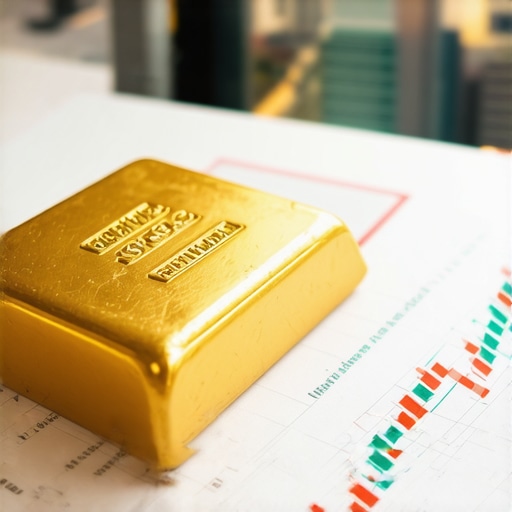Introduction to Gold ETFs: The Modern Investment Vehicle
In today’s dynamic financial markets, Gold Exchange-Traded Funds (ETFs) have emerged as a vital tool for investors looking to gain exposure to gold without the complexities of physical ownership. Gold ETFs offer a unique blend of liquidity, ease of trading, and diversification, making them an attractive option for both seasoned investors and newcomers alike.
What are Gold ETFs?
Gold ETFs are investment funds that hold physical gold bullion, allowing investors to buy shares of the fund instead of purchasing the gold directly. Each share typically represents a specific amount of gold, making it easy for investors to buy and sell shares on major stock exchanges. This structure not only simplifies the investment process but also provides the benefits of liquidity and lower transaction costs compared to traditional gold investments.
Benefits of Investing in Gold ETFs
Investing in Gold ETFs presents several advantages:
- Liquidity: Gold ETFs are traded on stock exchanges, enabling investors to quickly enter or exit positions during market hours, just like stocks.
- Cost-Effectiveness: Compared to buying physical gold, investing in ETFs generally incurs lower fees and expenses, as storage and insurance costs are managed by the fund.
- Diversification: Gold ETFs allow investors to diversify their portfolios by adding a tangible asset that often performs well during economic uncertainty.
Understanding Gold ETF Performance
Several factors influence the performance of Gold ETFs, including global economic conditions, inflation rates, and central bank policies. For instance, during times of economic instability, gold is often viewed as a safe-haven asset, leading to increased demand and higher prices. Additionally, understanding gold demand trends can provide valuable insights into potential price movements and investment opportunities.
The Role of Gold ETFs in an Investment Portfolio
Incorporating Gold ETFs into an investment portfolio can serve multiple strategic purposes. They can act as a hedge against inflation and currency fluctuations, as well as provide a counterbalance to more volatile asset classes like stocks. For investors seeking to build a diversified portfolio, understanding the role of gold is essential.
Choosing the Right Gold ETF
When selecting a Gold ETF, investors should consider various factors, such as the fund’s expense ratio, tracking accuracy, and the physical gold storage method. Additionally, it’s crucial to evaluate the ETF’s performance history in relation to gold price trends. Resources like gold price trends can help in making informed decisions.
As the landscape of gold investment continues to evolve, Gold ETFs remain a compelling option for those looking to capitalize on the potential of gold in today’s economy. By navigating the complexities of gold investment through ETFs, investors can strategically position themselves for long-term success.
Key Considerations for Gold ETF Investors
When delving into the world of Gold ETFs, investors need to consider several key factors that can significantly impact their investment outcomes. Understanding these elements not only helps in selecting the right ETF but also aids in crafting a robust investment strategy.
Expense Ratios and Fees
One of the primary considerations when investing in Gold ETFs is the expense ratio, which represents the fund’s annual operating costs expressed as a percentage of its assets. Lower expense ratios can enhance long-term investment returns, making it essential to compare different funds. For more on evaluating costs, check our guide on gold ETFs and mutual funds.
Tracking Accuracy
Another crucial aspect is how accurately an ETF tracks the price of gold. Ideally, investors want an ETF that closely mirrors gold price movements. This tracking efficiency can be influenced by the fund’s structure and management. Investors should research the fund’s historical tracking performance to ensure it aligns with their investment expectations.
Physical Gold Storage
Different Gold ETFs have varying methods for storing physical gold, which can affect the overall risk and security of the investment. Some funds store gold in secure vaults, while others may employ different strategies. Understanding these storage methods is vital, as they can impact the ETF’s liquidity and safety. For insights into gold storage options, refer to our article on the benefits of physical gold investments.
Market Trends Influencing Gold ETF Performance
The performance of Gold ETFs is closely tied to broader market trends and economic indicators. Investors should stay informed about various factors that could influence gold prices, including inflation rates, interest rates, and geopolitical events.
The Impact of Inflation
Gold is often perceived as a hedge against inflation, making it an attractive investment during periods of rising prices. As inflation increases, the purchasing power of currency diminishes, leading investors to seek safe-haven assets like gold. This relationship underscores the importance of tracking gold price forecasts and inflationary trends for making informed investment decisions.
Geopolitical Events
Geopolitical tensions can also play a significant role in gold price movements. During uncertain times, such as conflicts or economic instability, investors often flock to gold as a safe asset. Monitoring global news and understanding gold demand trends can help investors anticipate market shifts and adjust their portfolios accordingly.
Future of Gold ETFs: Emerging Trends
As the investment landscape evolves, Gold ETFs are likely to adapt to changing market conditions and investor preferences. Emerging trends such as the incorporation of technology in trading platforms and the introduction of new ETF products may reshape how investors engage with gold.
Technological Advancements
Advancements in technology, including blockchain and improved trading platforms, are making it easier for investors to access Gold ETFs. These innovations can enhance transparency and efficiency in trading, ultimately benefiting investors. For a detailed overview of trading strategies, explore our piece on gold trading techniques.
By keeping an eye on these developments, investors can position themselves to capitalize on the potential benefits that Gold ETFs offer in a rapidly changing financial environment. Understanding these dynamics will be crucial as we move forward into a new era of gold investment opportunities.
Investment Strategies for Gold ETFs: Maximizing Potential Returns
When investing in Gold ETFs, it’s crucial to develop effective strategies that align with market conditions and personal financial goals. Understanding different approaches can significantly enhance your investment experience and outcomes.
Long-Term vs. Short-Term Investment Approaches
Investors need to decide whether they aim for short-term gains or long-term growth. A long-term perspective often involves holding Gold ETFs to benefit from potential price appreciation over time, especially during periods of economic instability. Conversely, short-term trading may focus on exploiting market fluctuations and price volatility. For insights on navigating these strategies, consider our guide on improving your gold investment strategies.
Market Timing and Entry Points
Identifying the right time to enter or exit a Gold ETF position can be pivotal. Monitoring gold price trends and economic indicators can help investors make informed decisions. Utilizing tools such as technical analysis and market forecasts can provide clarity on potential entry points. To stay updated on market movements, our article on gold price forecasts is an excellent resource.
Risks Associated with Gold ETFs
Like any investment, Gold ETFs come with inherent risks that investors must understand to mitigate potential losses. Recognizing these risks can help in developing a more resilient investment strategy.
Market Volatility
The price of gold can be highly volatile, influenced by factors such as geopolitical tensions, global economic conditions, and changes in interest rates. Understanding how these factors affect gold prices is essential for managing risk. Investors should remain informed about current market trends to anticipate potential fluctuations.
Liquidity Risks
While Gold ETFs are generally liquid, some funds may experience lower trading volumes, leading to liquidity risks. This can result in wider bid-ask spreads and difficulties in executing trades at desired prices. It’s advisable to evaluate the trading volume and liquidity of specific Gold ETFs before investing.
Tax Implications of Gold ETF Investments
Understanding the tax implications of Gold ETFs is vital for effective financial planning. In many jurisdictions, profits from selling Gold ETFs may be subject to capital gains taxes, which can differ based on the holding period. Additionally, tax treatment can vary depending on whether the Gold ETF is classified as a collectible or a standard security. Consulting a tax professional can provide clarity on how to manage these implications effectively.
Strategies for Minimizing Tax Liabilities
To optimize tax efficiency, investors can explore strategies such as holding Gold ETFs in tax-advantaged accounts, like IRAs. This approach can help defer taxes on gains until distribution. For insights on managing tax implications in gold investments, refer to our guide on gold IRA investments.
Future Outlook for Gold ETFs
As the investment landscape continues to evolve, the future of Gold ETFs looks promising. Emerging trends, such as the increasing adoption of sustainable investing and the integration of technology, may reshape how investors engage with Gold ETFs. Staying abreast of these trends will be crucial for making informed investment decisions in the evolving market landscape.
Emerging Trends in Sustainable Investing
With a growing emphasis on sustainability, investors are increasingly looking for Gold ETFs that align with ethical investing principles. Funds that prioritize responsible sourcing and environmental considerations may attract more investors, influencing their performance. For more on ethical investing, consider exploring our article on effective gold investment strategies.
Investment Strategies for Gold ETFs: Key Takeaways
As investors explore the potential of Gold ETFs, understanding effective strategies is essential for maximizing returns. By focusing on the right approaches, investors can navigate the complexities of the gold market and enhance their portfolios.
Diversification Benefits of Gold ETFs
Including Gold ETFs in a diversified investment portfolio can provide a cushion against market volatility. Gold often behaves differently compared to other asset classes, such as stocks and bonds, especially during economic downturns. The role of gold in diversification cannot be overstated, especially as part of a balanced investment strategy.
Dollar-Cost Averaging Approach
One effective strategy for investing in Gold ETFs is dollar-cost averaging, which involves regularly investing a fixed amount over time. This method can help mitigate the impact of market fluctuations, allowing investors to purchase more shares when prices are low and fewer when prices are high. This disciplined approach can lead to lower average costs per share over time.
Understanding Gold Market Signals
Investors must stay attuned to key market signals that can influence the performance of Gold ETFs. Economic indicators, including inflation rates, interest rate changes, and geopolitical tensions, can significantly impact gold prices.
The Connection Between Interest Rates and Gold Prices
Interest rates play a crucial role in gold investment decisions. Typically, when interest rates are low, gold becomes more attractive as an investment, as the opportunity cost of holding non-yielding assets decreases. Conversely, rising interest rates can lead to lower demand for gold. To better understand these dynamics, refer to our article on gold price forecasts.
Geopolitical Tensions and Their Impact
Geopolitical events often lead to increased demand for gold, as investors seek safe-haven assets during periods of uncertainty. Keeping an eye on global events can provide critical insights into potential market shifts. Understanding gold demand trends during such times is essential for strategic investment planning.
Long-Term Prospects for Gold ETFs
The long-term outlook for Gold ETFs remains positive, especially as investors increasingly recognize the value of gold in hedging against inflation and economic uncertainty. The continuing evolution of the gold market underscores the need for investors to adapt their strategies accordingly.
Emerging Opportunities in Gold Investment
As the investment landscape shifts, emerging opportunities in gold investment are becoming more apparent. Innovations in trading technology and the introduction of sustainable gold ETFs are transforming the way investors engage with gold. For insights into sustainable investing trends, explore our article on effective gold investment strategies.
Conclusion: Positioning for Success in Gold ETFs
Investing in Gold ETFs offers a range of benefits, from liquidity to diversification. However, understanding market trends, implementing strategic investment approaches, and staying informed about economic indicators are essential for maximizing returns. As the landscape of gold investment continues to evolve, investors who remain proactive and adaptable will be best positioned for success.
Understanding Gold ETFs: FAQs
What are the fees associated with Gold ETFs?
Gold ETFs typically charge an expense ratio, which is the fund’s annual operating cost expressed as a percentage of its assets. Additionally, there might be brokerage fees when buying or selling shares, though these can vary by brokerage platform. Always check the specific ETF’s prospectus for detailed fee structures.
How do Gold ETFs compare to physical gold investments?
Gold ETFs provide a more liquid and cost-effective way to invest in gold compared to physical gold. Investors in ETFs do not incur storage or insurance costs, and they can easily buy and sell ETF shares on exchanges. However, physical gold offers tangible ownership, which some investors prefer.
Can I hold Gold ETFs in a retirement account?
Yes, many investors choose to hold Gold ETFs in retirement accounts, such as IRAs. This allows for tax-deferred growth on the investment. However, it’s essential to ensure that the Gold ETF complies with IRS regulations for retirement accounts.
What factors influence the price of Gold ETFs?
The price of Gold ETFs is primarily influenced by the price of physical gold, which is affected by factors such as market demand, geopolitical events, inflation rates, and interest rates. Keeping an eye on these indicators can help investors make informed decisions.
Are Gold ETFs a good hedge against inflation?
Historically, gold has been viewed as a hedge against inflation. When inflation rises, the purchasing power of currency decreases, leading investors to seek safe-haven assets like gold. Thus, Gold ETFs can serve as an effective hedge in inflationary periods.
What are the tax implications of investing in Gold ETFs?
Gains from Gold ETFs are typically subject to capital gains tax, which can vary based on holding periods. It’s important for investors to consult tax professionals to understand their specific tax obligations related to Gold ETF investments.
How do I choose the right Gold ETF?
When selecting a Gold ETF, consider factors such as the fund’s expense ratio, its tracking accuracy, and the method of gold storage. Comparing these elements across different funds can help in making an informed decision. Resources like gold price trends can aid in your evaluation.
Is it safe to invest in Gold ETFs?
While Gold ETFs are generally considered safe investments, they are still subject to market risks and price volatility. Investors should conduct thorough research and consider their risk tolerance before investing.
Can I invest in Gold ETFs with a small amount of money?
Yes, one of the advantages of Gold ETFs is the ability to invest with relatively small amounts of money. Investors can purchase shares of Gold ETFs at market prices, which can be more accessible than buying physical gold bullion.
Authority Resources for Gold ETFs
For further reading and to enhance your understanding of Gold ETFs, consider exploring the following trusted resources:
- SPDR Gold Shares – An authoritative source on Gold ETFs, providing insights and information on their gold-backed ETFs.
- U.S. Global Investors – Offers a range of educational resources and market insights related to gold investments.
- World Gold Council – A global authority on gold, providing research and data on gold’s role in investment and economic stability.
- Investopedia – A comprehensive resource for financial education, including detailed articles on Gold ETFs and investing strategies.
- Kitco – A leading source for precious metals news, prices, and analysis, including gold market trends.
Conclusion: Navigating the Gold ETF Landscape
Gold ETFs present a compelling investment option for those looking to diversify their portfolios and hedge against economic uncertainties. By understanding the various aspects of Gold ETFs, from their benefits and risks to market dynamics and strategic investment approaches, investors can better position themselves for success. As you explore the potential of Gold ETFs, staying informed about market trends and leveraging authoritative resources will be key to making sound investment decisions.











I appreciate the thorough breakdown of Gold ETFs and the various factors at play. Having invested in both physical gold and ETFs, I can attest to the liquidity and lower fees associated with gold ETFs. It simplifies the investment process and allows for strategic buying and selling during market fluctuations.
One aspect not covered extensively here is the emotional bias some investors hold towards physical gold versus ETFs. For those who feel a stronger attachment to holding tangible assets, transitioning to Gold ETFs may require a shift in mindset. However, I believe the diversification and hedging benefits during economic downturns can outweigh those concerns.
Organic trends suggest that with inflation rising, gold’s appeal is gaining momentum, particularly among younger investors. It’s great to see how technology is bringing more accessibility to gold investment through ETFs, making them viable options even for those starting with limited capital.
Overall, as we look at future trends, I believe Gold ETFs will continue to play a significant role, especially as more investors prioritize ethical investing. I’m curious if others here have similar experiences balancing between physical gold and ETFs?